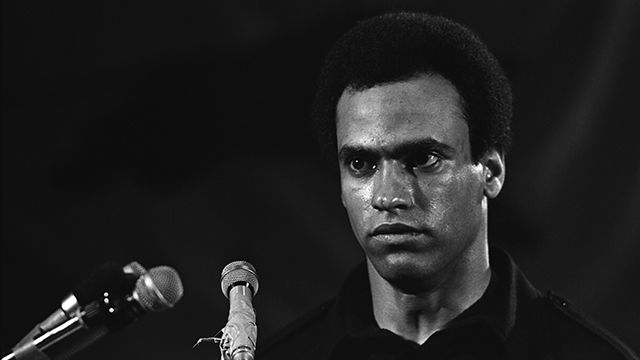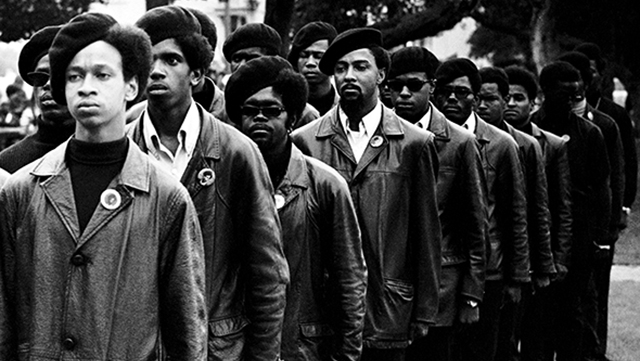The Black Panthers rose up as a grassroots organization during the late 1960s–a time of great social upheaval in the US. This was the Vietnam War, Cold War and civil rights era, when marginalized groups such as women, Latinos, American Indians, and African Americans were organizing to stand up against oppression and the status quo. College students around the country joined in these protests and coalitions were formed across many of these groups.
[media-credit name="Huey P. Newton at microphone/Independent Lens" align="aligncenter" width="640"] [/media-credit]
[/media-credit]
Huey P. Newton and Bobby Seale started the Black Panther Party for Self-Defense in Oakland, California in 1966. They drafted a 10-Point Program to address what they viewed as the roots of inequality in the black community. Their early actions involved monitoring police conduct in their community, providing free breakfast and healthcare programs, and utilizing their own media and mainstream media outlets to publicize a strong stance against police brutality and the structures of racism. By 1970, the group had offices in 68 cities and enormous appeal, especially for a younger generation who were frustrated with the slow pace of change.
The rise of the Panthers drew intense media attention and debate. The Party claimed the right to bear arms under the 2nd Amendment, and were often photographed carrying guns. The FBI classified the Panthers with domestic groups that they felt were a danger to national security, and targeted many members for surveillance through their counterintelligence program COINTELPRO. More than 20 Panthers remain in prison today, and others live in exile, sentenced for crimes associated with violent confrontations with police officers. Whether or not these Panthers received fair trials remains an issue of dispute.
Although the Party no longer operates today, many former Panthers continue to work for the same causes that inspired the Black Panthers–such as reforming the education and criminal justice systems. Their example has inspired many other radical social movements in the US and abroad, and their history continues to be hotly contested.
While there may be differences in opinion about the Panthers, it is undeniable that Stanley Nelson’s film is timely–after recent events in Ferguson and Baltimore and a slew of police-related deaths of African Americans. As the filmmaker said to the British newspaper The Guardian: “A year and a half ago, it might have been easier for critics to say, ‘Oh, these guys [the Panthers] look crazy, how could they do this?’, and not take it seriously. But I think now they’ll understand – or a lot of people will understand – that the magnitude of police mistreatment of African Americans is real and it’s been going on for a long time.”
More Resources
WEBSITE: The Black Panther Party: Through a KQED Lens (KQED)
Our cameras were there at the rallies in the ’60s and our reporters are still covering the story today, as our culture reflects on what’s changed, what hasn’t, and how, despite the demise of the party, Panther ideals live on today. This website contains archival clips of KQED coverage of the Black Panthers Party, along with other resources.
DISCUSSION GUIDE: The Black Panthers: Vanguard of the Revolution Discussion Guide (Independent Lens)
A discussion guide to support schools and organizations screening the documentary film. The guide is a tool to facilitate dialogue and deepen understanding of the complex topics in the film.
VIEWING GUIDE: The Black Panthers: Vanguard of the Revolution (San Francisco Film Society)
Discussion questions and supplemental materials facilitate further research into related topics such as government surveillance, the role of media in shaping a movement, and the relationship between peaceful and violent protest.
LESSON PLANS: African American Women Lead (ITVS Community Classroom)
This curricula collection features three films about extraordinary African American women leaders:Daisy Bates: The First Lady of Little Rock, The Interrupters, and The Black Power Mixtape 1967 – 1975. The first lesson considers the crucial leadership of largely forgotten civil rights activist Daisy Bates in the desegregation of Central High School in Little Rock, Arkansas. The second introduces Ameena Matthews — a former drug-ring enforcer who now uses her unique skills to intervene in conflicts before they turn to bloodshed. The final lesson examines the legacy of former Black Panther Angela Davis and her profound impact on liberation movements around the globe.
Do Next

 [/media-credit]
[/media-credit]